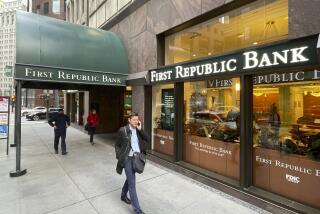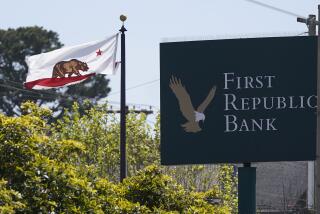Strain on S&Ls;, FSLIC Recalls Another Era
- Share via
Sometimes history does repeat. In the 1920s, banks competed for deposits by paying high interest rates and then made risky loans to earn more than they were paying to depositors.
Risky loans often go bad, and many did in the 1920s, leading to more than 10,000 bank failures and the loss of life savings by millions of people in the Depression of the 1930s.
So the government stepped in with insurance for deposits and regulations on how much banks could pay for deposits--extending both deposit insurance and rate regulation to savings and loan associations.
That restored the confidence of savers and ended the destructive competition for deposits. The result was almost 50 years of rising prosperity with affordable credit for housing and for business.
But that happy system has broken down. Under pressure from inflation, the government ended almost all regulation of interest rates in 1980 so that banks and S&Ls; could pay more to attract deposits. It had already increased the amount of federal insurance to $100,000 per deposit, where it stands today.
So what has happened? In the past decade we’ve seen a return to competition for deposits. Right now, S&Ls; and banks pay 8% and more on insured deposits of less than one year--often more than uninsured investments of the same duration.
And that makes no more economic sense in the 1980s than it did in the 1920s. Many S&Ls; have attempted to earn money on high-interest deposits by investing in or making loans to risky ventures. And many--at least 500 and probably more than 900 of the nation’s 3,092 S&Ls--have; become insolvent as a result, a situation that is arousing intense alarm in Washington because it’s evident that the industry-financed Federal Savings & Loan Insurance Corp. won’t even come close to covering the damage.
Bank in Better Shape
That means Congress will have to appropriate taxpayers’ money to see that savers don’t lose their deposits as they did in the 1930s.
Lots of taxpayers’ money. Sen. William Proxmire, head of the Senate banking committee, estimates that bailing out the S&Ls; will cost taxpayers $20 billion. The General Accounting Office estimates that the total cost to the federal insurance fund and taxpayers of rescuing insolvent S&Ls; will be $50 billion, and the American Bankers Assn.--which fears that its own Federal Deposit Insurance Corp. will be tapped to pay for S&L; losses--estimates the costs at $74 billion and calls on Congress to set up a $100-billion S&L; rescue fund.
(Banks are in better shape than S&Ls;, but not wholly healthy either. Rescues of big Texas banks will force FDIC to pay out more in bailouts than it takes in in premiums this year).
What went wrong? S&L; managers went hog wild with other people’s money. Set up to aid residential housing, S&Ls; in Texas financed commercial projects that have gone bust in the long energy depression. Elsewhere, S&Ls; simply turned to gambling on interest rates by trading in mortgage certificates. When they bet right, they booked a profit; when wrong, they added the losses to other non-earning assets. Few worried about bad loans; even incompetently managed S&Ls; could always attract new deposits because they offered insurance.
But many are worried now. FDIC and others in the federal government are studying ways to “reform” deposit insurance--which means provide less of it. But they’ll have to move gingerly because the system is fragile; any suggestion of change could cause hurried withdrawals of deposits--often big deposits. Banks and corporate treasurers frequently invest in S&Ls;, breaking down million-dollar deposits into $100,000 units to qualify for the federal insurance that was set up to safeguard small savers. At that, the $100,000 limit on insurance has lost its meaning as the federal government backed multimillion-dollar deposits in the 1984 failure of Continental Illinois Bank, and is backing big deposits today in the rescue of American Savings & Loan.
What can be done to remedy the situation? Clearly increased supervision is needed to prevent imprudent loans being made at public expense. “For the $1 billion that was lost by a small Northern California S&L;,” observes analyst Jonathan Gray of the Sanford C. Bernstein research firm, “the government could provide lifetime employment to 800 bank examiners.”
And some way needs to be devised--suggests the bank consultants Sheshunoff & Co.--to differentiate the interest rate between insured deposits and non-insured investments, to return the business to sound principles.
A reimposition of regulated interest rates could do it--if the regulated rate on an insured deposit could rise and fall but stay lower than the rate on other uninsured investments that could be offered by the bank or S&L.; The word may sound odd--regulation having been out of fashion for years, and savers having become accustomed to earning more than the old 5% passbook rate. But the idea is right in principle: a safe investment paying a lower rate than a risky one.
And it has been right in practice: Regulated interest rates helped banks and S&Ls; finance decades of growing prosperity. Maybe history can repeat in positive ways, too.
More to Read
Inside the business of entertainment
The Wide Shot brings you news, analysis and insights on everything from streaming wars to production — and what it all means for the future.
You may occasionally receive promotional content from the Los Angeles Times.










